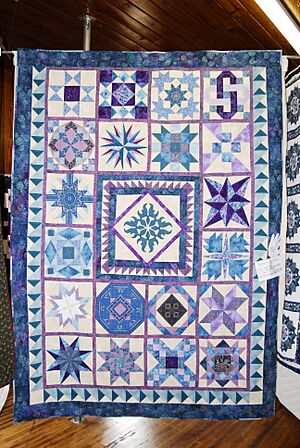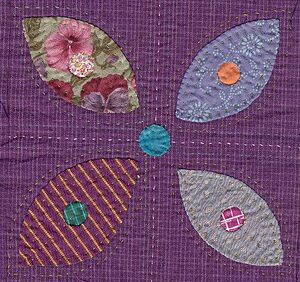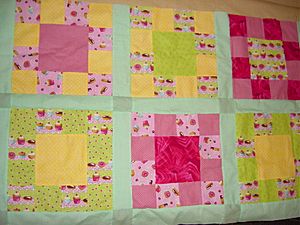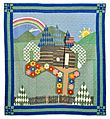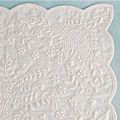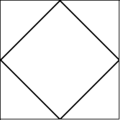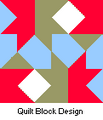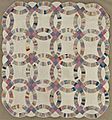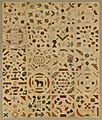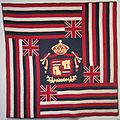Quilt facts for kids
A quilt is a special kind of blanket. It has three layers. The top layer is usually made of cloth. The middle layer is a soft, warm material called batting. The bottom layer is another piece of cloth for backing. These layers are joined together. People can sew them or tie them with yarn, thread, or ribbon.
Often, the top layer of a quilt is made from many small pieces of cloth. These pieces are sewn together to create beautiful patterns. This is called patchwork. You can also make patterns by stitching lines through all three layers.
Quilts are not always used as blankets. Some are made as art to hang on walls. Others are used just for decoration. People make quilts in many places around the world. This includes the Amish community, Hawaii, and India.
Contents
Why People Make Quilts
People make quilts for many different reasons. Quilts can mark important moments in life. These include weddings, the birth of a baby, or someone leaving home. Today, quilts are not just for beds. They can be wall hangings, table runners, or tablecloths. Quilting ideas are also used in clothing design. There are even quilt shows and competitions. These happen locally, nationally, and internationally.
Here are some common reasons to make a quilt:
- To use as a warm blanket for a bed.
- For decorating a home.
- As a type of armor in the past.
- To remember important events or people, like the AIDS Memorial Quilt.
- For teaching, like a "Science" or "Gardening" quilt.
- To support a cause or campaign.
- To record history or events.
- As a form of art.
- To give as a thoughtful gift.
- To raise money for good causes.
Quilting History and Traditions
Quilting has a rich history, especially in the United States. Early settlers needed warm bedding. But fabric was expensive and hard to get. People had to use every small piece of cloth they had. They would save fabric scraps and sew them together. This created larger pieces called "blocks." These blocks could be simple or have creative designs.

Quilting was often a group activity. Women and girls in a family or community would work together. Men also took part in quilting traditions. They would prepare the quilt top beforehand. Then, a "quilting bee" would be held. Many people would gather to do the actual quilting. Large frames were used to hold the quilt layers tight. This helped make neat stitches. Quilting bees were also important social events. They often happened when there wasn't much farm work to do.
Quilts were often made for big life events. Weddings were a common reason. In the past, young women were expected to have many quilts ready for their new home before marriage. This helped them have enough time to settle into their new role. Today, people still make special wedding quilts. The "Wedding Ring" quilt, with its interlocking rings, has been popular since the 1930s. White quilts with fancy stitching were also traditional for weddings. Some believed it was bad luck to put heart shapes on a wedding quilt. So, tulip designs were often used to show love instead.
Quilts were also made for graduations or when people moved away. For example, communities made "subscription quilts" as farewell gifts for pastors. People would pay to have their names sewn onto the quilt. The money would go to the departing minister. Sometimes, these quilts were even auctioned off to raise more money. The winner might then give the quilt back to the minister. This idea grew, and quilts were made to raise money for other community projects. This included helping after floods or for war efforts. Today, quilters make quilts for wounded veterans.
William Rush Dunton (1868–1966) was a doctor who studied American quilts. He used quilting to help his patients. He believed it was a good way for them to heal and stay busy.
Quilting Techniques
Quilters use many different ways to create their beautiful works. Here are some common techniques:
Patchwork and Piecing
Patchwork is a main technique in quilt making. It means sewing together small, often geometric, pieces of fabric. These pieces form a design or a "block." This is also called piecing. You can do this by hand or with a sewing machine.
Appliqué
Appliqué is when you sew a piece of fabric onto a larger background fabric. The top fabric can be any shape. There are different ways to do appliqué. In "needle-turn appliqué," the edges of the top fabric are folded under. This stops them from fraying. Small, hidden stitches are used to sew the shape down. Sometimes, the background fabric is cut away from behind the appliqué. This makes the quilt less bulky. A special type is Broderie perse. Here, you cut specific designs, like flowers, from one fabric. Then you sew them onto a new fabric to create a new picture.
Reverse Appliqué
Reverse appliqué is a bit different. You cut a shape out of the top fabric. Then, you place another fabric underneath. The cut edges of the top fabric are folded under and sewn down to the fabric below. The stitches are made to be very hard to see. This technique is often used with regular appliqué to create different looks.
Quilting Stitches
The stitches that hold the three layers of a quilt together are called "quilting." These are usually running stitches. You can do them by hand or with a sewing machine. Hand quilting was often a group activity. Quilters would sit around a large frame. You can also hand quilt using a hoop. With the invention of the sewing machine, many quilters started using machines. Today, machine quilting is very common, especially with longarm machines.
Trapunto
Trapunto is a technique that makes parts of the quilt stand out. Two layers of fabric and batting are quilted together. Then, extra batting is added to certain areas. This makes those parts puff up. The areas around them are often quilted very closely. This makes the background look flatter, making the raised parts stand out even more. You can also use cording. This is when you create a channel with stitching and pull a cord or yarn through the batting. This adds a sharp texture change. For example, you might quilt flower shapes and then push extra batting into them. The stem could be corded to make it dimensional.
Embellishment
You can add extra decorations to a quilt. This makes it look more three-dimensional or fun. Common additions include beads or buttons. You can also sew on decorative trim, piping, sequins, or other small objects.
English Paper Piecing
English paper piecing is a hand-sewing method. It helps you sew complex shapes together very accurately. You cut a paper shape that is the exact size of the fabric piece you need. Then, you temporarily sew the fabric to the paper shape. Next, you place two fabric pieces face to face. You sew their edges together with a whipstitch. Once a piece is completely surrounded by other shapes, you remove the temporary stitches and the paper.
Foundation Piecing
Foundation piecing is a sewing technique that keeps your work stable. It helps prevent fabric from stretching or getting distorted, especially with thin or oddly cut pieces. In its simplest form, you cut a piece of paper the size of your desired block. Old newspapers were sometimes used for utility quilts. Today, special papers are available. You machine-sew a strip of fabric onto the paper. Then, you flip the fabric back and press it flat. You add the next fabric piece, sewing it through the first piece and the paper. You keep adding pieces in order. After the block is done, the paper is usually removed. However, if the paper is acid-free, it can sometimes stay.
Images for kids
-
1940 photograph by Russell Lee of Mrs. Bill Stagg of Pie Town, New Mexico with state quilt.
-
Harriet Powers' 1898 bible quilt.
-
Anna Williams (American, born 1927). Quilt, 1995. Cotton, synthetics Brooklyn Museum.
-
Seminole patchwork shawl made by Susie Cypress from Big Cypress Indian Reservation, ca. 1980s.
-
American. Double Wedding Ring Quilt, ca. 1930. Cotton. Brooklyn Museum.
-
A friendship quilt, circa 1920, at the Audie Murphy American Cotton Museum in 2015.
-
Pictorial Quilt, 1795. Linen, multicolored thread. Brooklyn Museum.
-
American. Pictorial Quilt, ca. 1840. Cotton, cotton thread. Brooklyn Museum.
-
Group of people from Niʻihau with their quilt, 1885.
-
Kuʻu Hae Aloha (My Beloved Flag), from Waimea, before 1918, Honolulu Museum of Art.
See also
 In Spanish: Quilt para niños
In Spanish: Quilt para niños


